Daniel 1-7
Introduction
Daniel was a young man when he was taken into exile in Babylon with the people of Judah, before the group that would include Ezekiel. Many have tried to push the date of writing past the events predicted, out of nothing but bias against divine inspiration, because the prophecies concerning historical events are so accurate and detailed. Jesus referred to Daniel specifically, as also did Ezekiel. Please refer to these resources as well: this commentary, the NETS Bible, and this LXX Interlinear.
Daniel 1
The book of Daniel begins with historical context, that being his deportation to Babylon by King Nebuchadnezzar. But the king knew the value of people of character and intelligence, so he had his official search for standouts among the captives. These were to be treated well, fed from the king’s table, and educated in the literature and language of Babylon. Some today would consider accepting such an offer an act of betrayal, but this is short-sighted; most rebellions require infiltrators in high places. However, in this case, it was God’s long-range plan to bring a remnant back from exile. So always seek God’s will if you find yourself— or are tempted to bash someone else— in a similar situation.
It turns out that Daniel and three of his friends were among the chosen, and all of them were given Babylonian names. It’s curious that tradition has always referred to Daniel by his Hebrew name, while his friends are called by their Babylonian names. Now in verse 8 it says that Daniel didn’t want to be defiled by the king’s food, so he asked to be fed a vegetarian diet. Some take this as a divine mandate for vegetarianism, but it’s nothing of the sort; it was a choice to eat only that which was permitted by the law of Moses, in a foreign land where the meat did not qualify. The law allowed and even presumed the eating of clean meats.
Because of this brave stance, God blessed Daniel and his friends with great knowledge and skill, but Daniel was also given prophetic insight. So after the three-year training period, these four people impressed the king more than all the others, and Daniel himself would live through the entire span of the neo-Babylonian empire, as shown in verse 21.
Daniel 2
 Now begins the king’s experiences of many strange dreams. But he doesn’t remember a particular one, and he demands that his astrologers tell him both the dream and its meaning. After they become exasperated with the threat of a horrible death because they have no real psychic ability, we see in verse 10 that they and all the other “wise men”, including Daniel and his friends, were to be rounded up and executed.
Now begins the king’s experiences of many strange dreams. But he doesn’t remember a particular one, and he demands that his astrologers tell him both the dream and its meaning. After they become exasperated with the threat of a horrible death because they have no real psychic ability, we see in verse 10 that they and all the other “wise men”, including Daniel and his friends, were to be rounded up and executed.
But Daniel was granted time to prevent the executions, so he had his friends all pray for God’s mercy and interpretation. Upon receiving it, we see in verse 19 that Daniel praises God, another thing we Christians need to remember. Then in verse 25 he informs the official that he is ready to appear before the king with the answers. And he begins by crediting God with this insight, rather than taking credit for himself— yet another reminder for us Christians.
The dream itself was of the statue you see here, made of metals from head to toe in decreasing order of value. The interpretation begins in verse 37 and extends through verse 45. It is a prophecy of four world empires beginning with King Nebuchadnezzar as the head of gold. The next to come, the silver part, would be less powerful, which turned out to be that of Medo-Persia. After that would come the bronze part representing the even less-powerful Grecian Empire, followed by the iron legs representing the least-powerful Roman Empire. The feet of a mixture of iron and clay are not a fifth empire but a description of the fourth in its final stages. It will become weak because it will attempt to force together people groups who aren’t compatible.
Some take the phrase “mingling with the seed of men” as meaning hybrid humans or Nephilim. But we should note first of all that the word for men means common, ordinary people as opposed to rulers or elites, and the word for mingling means trading or associating. So it seems the interpretation with the best support is that this represents a mixture of incompatible cultures, governments, and economies, brought about by Rome’s wide-ranging conquest. The present EU is a good example; it was forced into a union that has never really unified except in the power class, who keeps trying to force it on unwilling populations. We also see the desperate attempt to break resistance to it by injecting middle easterners in large numbers, but this too is failing.
Many have also tried to put significance into both the two legs and the ten toes, saying that the legs represent the eastern/western divison of the Catholic Church (Roman and Greek), but then we must ask why a similar argument isn’t made for the statue’s two arms. The passage gives no indication that either the number of arms and legs or the number of toes has any significance. And last but not least, “in the days of those kings” the divinely-cut stone, representing the everlasting kingdom of the Messiah, will permanently destroy the Roman Empire in the end times.
When the king realized that Daniel had rightly described and interpreted the dream, he bowed to him and ordered people to make sacrifices to him. But we know he wasn’t being made a god, because the king gave honor to Daniel’s God as the one above all others. However, he was elevated to a very high government position, to which Daniel hired his friends as assistants. But as the saying goes, “No good deed goes unpunished”.
Daniel 3
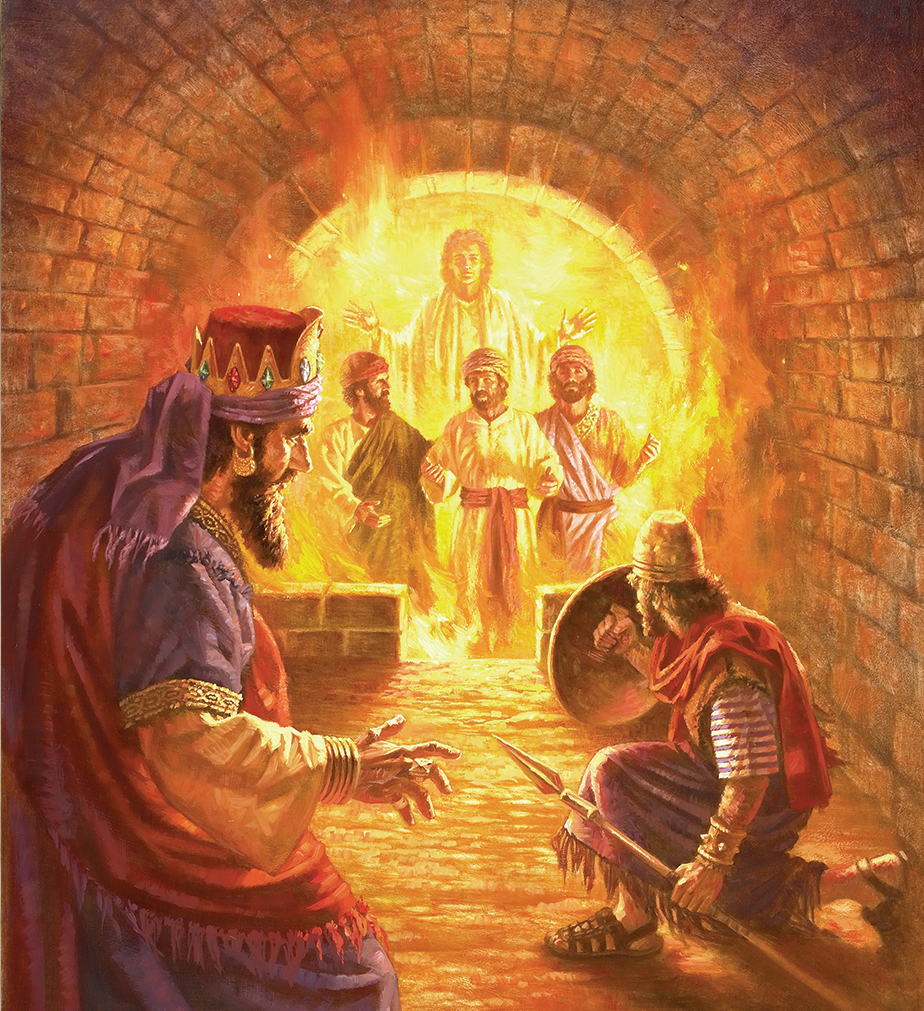 We see here how short-lived such honors can be. The king decides to build a giant statue that everyone would be obligated to worship, on pain of death by being thrown into a furnace. Of course, the formerly demoted astrologers saw the opportunity to be rid of these Hebrew upstarts, so we see in verse 8 that they eagerly expose Daniel’s friends as lawbreakers who refused to worship the statue; there’s no mention of Daniel here but only his friends. So the king, who seemed to have the memory and loyalty of a goldfish, has them arrested and gives them one last chance to comply.
We see here how short-lived such honors can be. The king decides to build a giant statue that everyone would be obligated to worship, on pain of death by being thrown into a furnace. Of course, the formerly demoted astrologers saw the opportunity to be rid of these Hebrew upstarts, so we see in verse 8 that they eagerly expose Daniel’s friends as lawbreakers who refused to worship the statue; there’s no mention of Daniel here but only his friends. So the king, who seemed to have the memory and loyalty of a goldfish, has them arrested and gives them one last chance to comply.
But in verse 16 they issue a challenge of their own: They will gladly be thrown into the furnace, where either they’ll die or they’ll be miraculously delivered, but either way they won’t worship the statue. So the king flies into a blind rage and has the fire stoked to much higher temperatures than normal, then has strong soldiers throw them in. But the only people killed are the soldiers!
Then the king sees four people in the fire, all walking around unharmed and unbound, and the fourth appears to be supernatural. So the king calls them to come out of the furnace, though the supernatural being does not. They’re found to be completely unharmed by the fire, so in verse 28 the king comes to his senses and praises the God who protected them. Further, he orders all of Babylon to honor their God. Does anyone still think these Hebrews were traitors?
Daniel 4
This passage shows the content of the edict from the king about all this, though the first three verses really belong to the end of ch. 3, and that’s how the Greek text has it. What follows is a completely separate incident, another dream. This time he tells his astrologers the dream, but they still can’t interpret it. So once again it’s Daniel to the rescue.
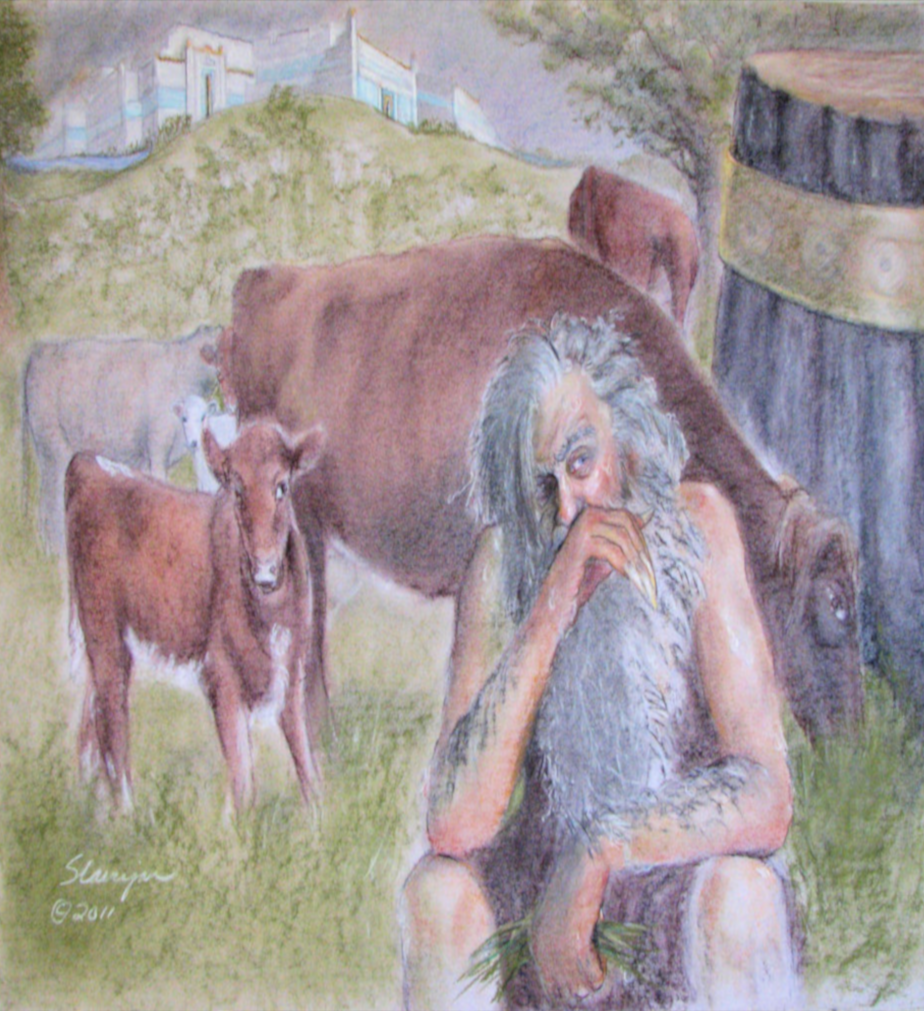 The dream is about a huge tree, which is ordered to be chopped down but its taproot left in the ground, where it would be covered in dew and left with the animals. Then the text turns to the actual meaning and says that “his” mind would be turned into that of an animal for seven years, to teach him that God has authority over human kingdoms. But the interpretation in verse 19 shows just how harsh the lesson will be, and it disturbs Daniel to the point where he’s very reluctant to give it.
The dream is about a huge tree, which is ordered to be chopped down but its taproot left in the ground, where it would be covered in dew and left with the animals. Then the text turns to the actual meaning and says that “his” mind would be turned into that of an animal for seven years, to teach him that God has authority over human kingdoms. But the interpretation in verse 19 shows just how harsh the lesson will be, and it disturbs Daniel to the point where he’s very reluctant to give it.
Daniel tells him that he will be stricken with the mind of an animal and driven from human contact, where he’ll eat grass with the animals and live outside, for the alotted seven years. But like the preserved taproot, the king would get his mind and kingdom back, because he would finally understand that everything he is and has is only by God’s decree and mercy. Notice that in verse 27 Daniel pleads with the king to stop sinning so this doesn’t happen, because the king had been turning a blind eye to the plight of the poor.
But it isn’t until a year later that the seven years of madness began, when the king boasted that everything was due to his own power and skill. As soon as the words left his mouth, a voice from heaven rebuked him and off he went. Now in verse 34 he is quoted as saying that his sanity returned as predicted once the seven years were passed, and the kingdom was restored to him.
Daniel 5
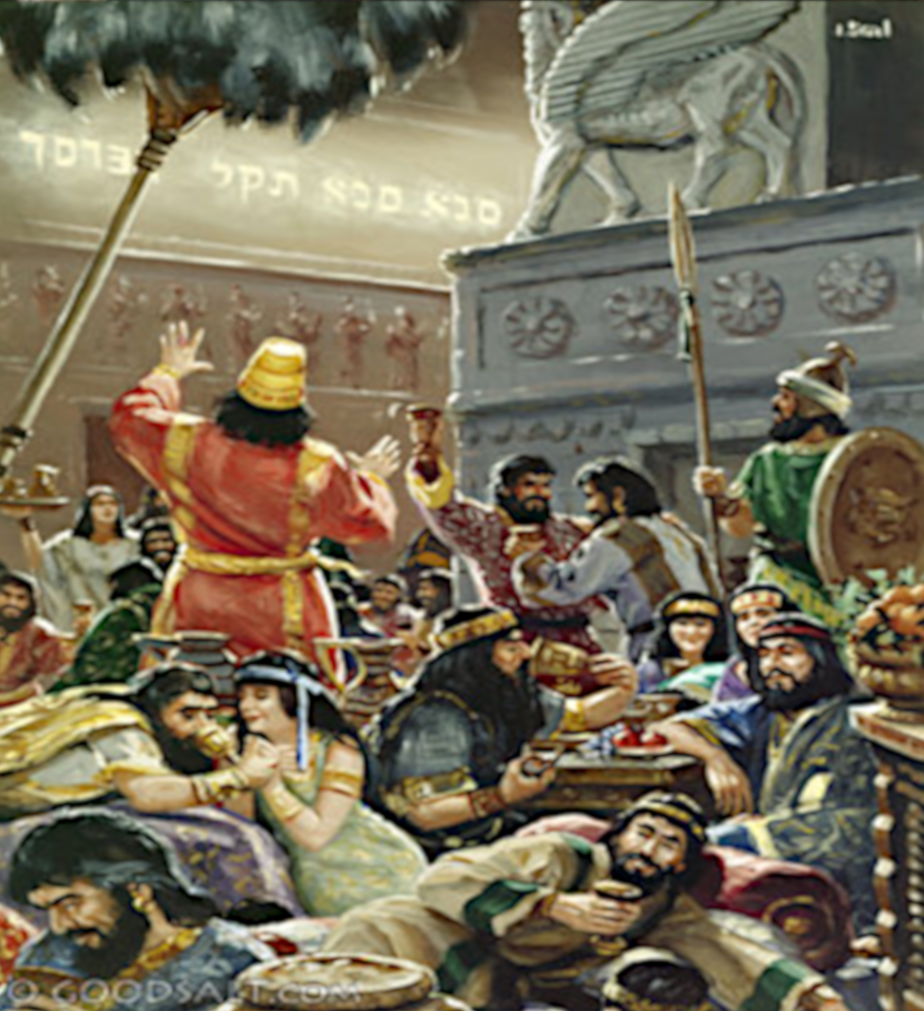 Without any other explanation, the text turns here to the reign of Belshazzar, second in command to someone extra-Biblical texts call Nabonidus. This is why Belshazzar would promise to make someone the third ruler of Babylon, he being the second in command. Check the commentary for more details of names and years passing in all this. But he’s most famous for an expression many don’t realize comes from the Bible: “the hand writing on the wall”.
Without any other explanation, the text turns here to the reign of Belshazzar, second in command to someone extra-Biblical texts call Nabonidus. This is why Belshazzar would promise to make someone the third ruler of Babylon, he being the second in command. Check the commentary for more details of names and years passing in all this. But he’s most famous for an expression many don’t realize comes from the Bible: “the hand writing on the wall”.
Belshazzar was partying and drunk when he made the grave mistake of having everyone drink wine from the gold and silver cups that had been taken from God’s temple in Jerusalem. They even praised their gods of metal, wood, and stone while they drank. So God let them see something they didn’t expect to see even in that condition: a disembodied hand writing mysterious words on the wall. So the king calls for his astrologers and offers great wealth and honor to whoever could explain this, but of course his astrologers were as useless as all the others before them. Yet even today, people consult astrologers and believe they have “scientific” proof that the stars order their lives.
But at least the queen mother has a better memory than a goldfish, and she tells them to send for Daniel. When he arrives, he tells Belshazzar to keep his gifts and honors, because he’ll give the meaning for free. His message is that Belshazzar didn’t learn the lesson taught to Nebuchadnezzar and had no humility or respect for God. So in verse 25 we see that the words on the wall mean that Belshazzar’s days are numbered, that his life is not measuring up, and that the kingdom of Babylon was about to be divided up between the Medes and Persians, as we recall from the vision of the statue. He was killed that very night and replaced by Darius the Mede.
Daniel 6
Darius kept Daniel as an advisor, who once again impressed the new king. But as before, the others were jealous of the honors bestowed upon him. Yet because he lived such a clean life that they couldn’t catch him on corruption charges, they hatched a plot to get him executed because of his God. That same tactic is used often today, whenever some pesky, clean-living Christian gets in the way of other people’s plans.
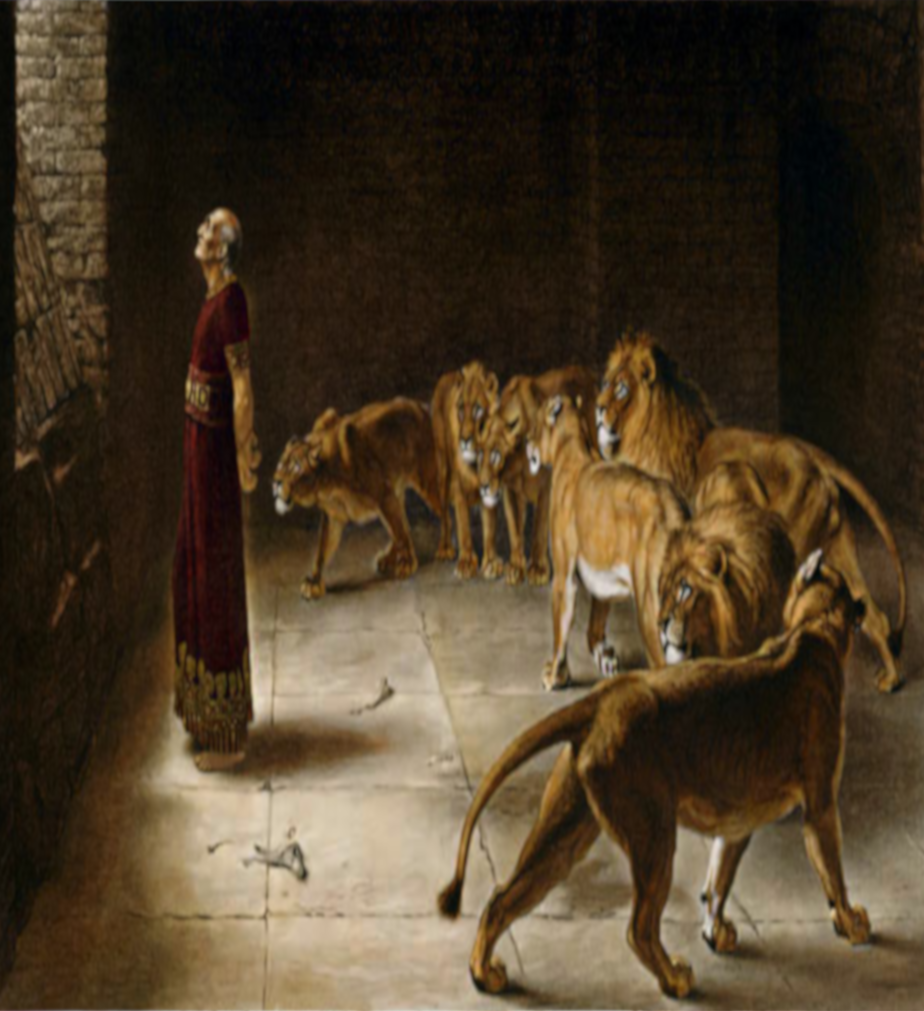 They advise the king to make a permanent and inflexible law that for the next thirty days, whoever worships any god or king but him should be thrown into a den of hungry lions. Daniel hears about it and immediately breaks the law by praying to God as he always had. Of course, the jealous schemers knew his habits and “just happened” to catch him in the act. So off they go to snitch to the king, who tries his best to find a legal loophole to get Daniel out of this predicament. But the snitches tell him it’s no use, so the order is given to throw Daniel to the lions.
They advise the king to make a permanent and inflexible law that for the next thirty days, whoever worships any god or king but him should be thrown into a den of hungry lions. Daniel hears about it and immediately breaks the law by praying to God as he always had. Of course, the jealous schemers knew his habits and “just happened” to catch him in the act. So off they go to snitch to the king, who tries his best to find a legal loophole to get Daniel out of this predicament. But the snitches tell him it’s no use, so the order is given to throw Daniel to the lions.
At least Darius escorts him there, hoping that God would protect him. And this was no mere hole in the ground; it was covered with a heavy stone and sealed off, much the way the temporary tomb of Jesus would be done. After a sleepless night, the king hurries back to the den and calls out to Daniel, who as we can see in verse 21 was unharmed. So he is lifted out of the den, but the king quickly gives another order: to throw in the snitches and their families, who are chewed up before they even hit bottom.
Then Darius sends out a notice to the whole land that only Daniel’s God was to be worshiped. Now we can’t always expect to be rescued for our faithfulness, as we see in Heb. 11, but we do see that in this case it caused many to turn to the one true God. Verse 28 adds that Daniel lived on through the reign of Darius to that of Cyrus the Persian. So ends the primarily historical section of the book, and now it’s back to more detail given in a different way about the vision of the statue.
Daniel 7
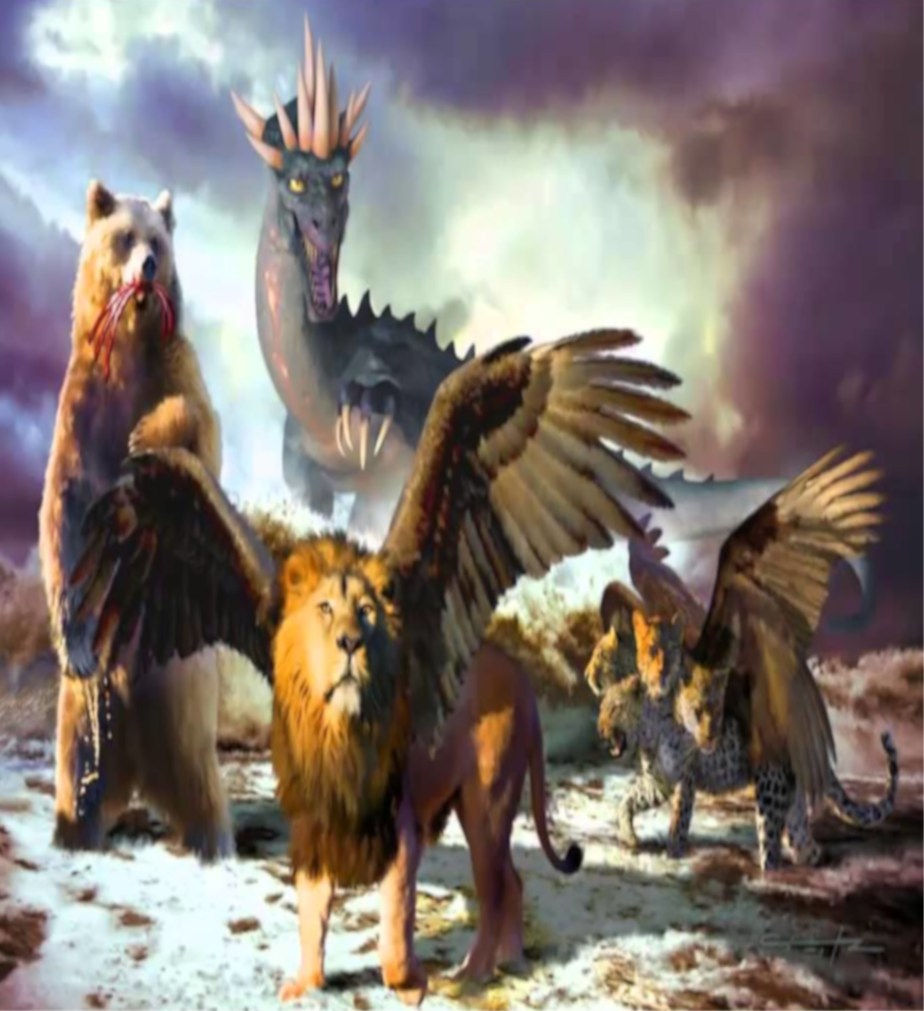 Notice first of all that this vision comes during the reign of Belshazzar rather than Cyrus. Also notice that it is given to Daniel rather than the king, and that the interpretation is given to Daniel by an angel. You might also want to view the chart in the commentary on this passage, which compares the two visions.
Notice first of all that this vision comes during the reign of Belshazzar rather than Cyrus. Also notice that it is given to Daniel rather than the king, and that the interpretation is given to Daniel by an angel. You might also want to view the chart in the commentary on this passage, which compares the two visions.
These beasts all come out of the sea, meaning the Gentile nations. The first was something like a winged lion, whose wings were torn off, after which it stood on two legs like a human and was given a human’s mind. The second was like a bear, and it had three ribs in its mouth and was told to go out and devour more. The third was like a leopard having four wings on its back and four heads, and it was given authority to rule.
The fourth was not compared to any known animal, but it was fearsome and powerful, with two rows of iron teeth. It crushed and trampled everyone and everything, and it had ten horns. But as Daniel watched, a small horn grew up among the ten and three other horns were torn out to make room for it. This “little horn” had human-like eyes and a boastful mouth. Then in verse 9 Daniel sees the throne of God, and by comparing it to the description in the first chapter of Revelation, we see that this is much like Jesus in his glory before he took on human flesh as stated in Phil. 2:5-11. Notice in verse 10 that the scene is a courtroom, and the books opened should be understood in that context.
Daniel sees that the fourth beast was killed and thrown into the fire, which is described also in Rev. 19:20. Here, the other beasts were allowed to continue ruling for “a time and season”. But then in verse 13 Daniel turns his attention to someone described as human-like, who approaches the Ancient One by coming “with the clouds”, as referenced in Mat. 24:30 and Rev. 1:7. So both the Father and the Son are described in very similar terms, which shouldn’t surprise us if we understand that Jesus has always been God but also became human at a point in time.
Now before we try to guess the meanings, Daniel is given them so we can’t allegorize them, especially since the animals are the symbols. Again the vision reveals a succession of kingdoms, but Daniel is particularly curious about the fourth one. Notice additional detail in verse 21: The “little horn” waged war against “the holy ones” and was defeating them, which of course cannot apply to the church, since in Mat. 16:18 Jesus said that could never happen. But the Ancient One prevents their complete annihilation, and the court scene mentioned earlier is to judge in their favor.
The explanation of the fourth kingdom is given in verse 23: It will conquer and subjugate the whole world. Ten kings will rise to power within it, followed by an 11th who topples three of them. He will blaspheme God and relentlessly persecute any who follow him. Then he will attempt to change “lawfully-appointed times”, a likely reference to either the Hebrew sacred calendar or to a doomed effort to thwart the prophecies of God. The phrase “a time, times, and half a time” throughout Daniel is held by pretty much everyone to mean 3-1/2 years, and we’ll see more about this in ch. 9. But that’s the length of the reign of this boastful king, which ends with the heavenly court’s decision to remove him from power and banish him forever.
Now before we end this vision of prophecy, notice more references in Revelation, especially ch. 17. As the commentary points out, Daniel and Revelation have similar structures: introduction, worldwide judgments, and focus on Israel. These are some of the many reasons why Revelation is the “unsealing” of Daniel’s end-tmes prophecies, and how we know that the judgments of Revelation span seven years. For those who say all of this was fulfilled by the end of the first century a.d., they must appeal to allegory since these things clearly have not happened.

